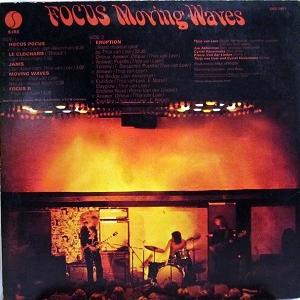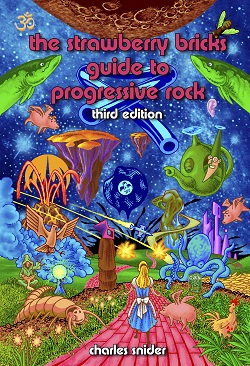Moving Waves
by Focus


Artist:
Focus
Label:
Sire
Catalog#:
SAS 7401
Format:
Vinyl
Country:
United States
Released:
1971-10
| Tracklist | |||
| A1 | Hocus Pocus | 6:35 | |
| A2 | Le Clochard ("Bread") | 1:55 | |
| A3 | Janis | 3:00 | |
| A4 | Moving Waves | 2:30 | |
| A5 | Focus II | 4:00 | |
| B1.I | Orfeus, Answer, Orfeus | ||
| B1.II | Answer, Pupilla, Tommy, Pupilla | ||
| B1.III | Answer, The Bridge | ||
| B1.IV | Euridice, Dayglow, Endless Road | ||
| B1.V | Answer, Orfeus, Euridice | ||
Credits
Bass, Vocals - Cyril Havermans
Drums - Pierre Van Der Linden
Guitar [Solo], Acoustic Guitar, Bass - Jan Akkerman
Organ, Harmonium, Mellotron, Flute [Soprano, Alto], Piano, Vocals - Thijs Van Leer
Notes
Recorded April 13 and May 14, 1971 at Morgan Studios, London.
Side 2--Based on a musical idea by Thijs Van Leer
Strawberry Bricks Entry:
There’s a seeming tradition in the Netherlands, beginning with the original Dutch export Ekseption, of souping-up classical music themes into a rock format. Focus ventured onto this path, but borrowed more from the Baroque and Renaissance eras; and more importantly, used those influences to create something of their own. Keyboardist and flautist Thijs van Leer formed the group in 1969 as the pit band for the Dutch production of Hair. At the end of the year, guitarist Jan Akkerman was recruited from another Dutch rock band, Brainbox. Their debut album, In And Out Of Focus, was a substantial hit across Europe, owing much to the Jethro Tull-clone single “House of The King” b/w “Black Beauty” (oddly omitted from the US release). The remainder of the album is just as solid: Akkerman’s guitar is fierce, even when the surrounding compositions seem lightweight. But then Focus broke up. Subsequently Akkerman teamed up with countrymen Cyril Havermans and former Brainbox drummer Pierre van der Linden, before inviting Van Leer and the name Focus back. Thus reconstituted, they recorded Moving Waves in London, with Mike Vernon producing. The wild guitar playing of Jan Akkerman and the are-you-serious yodeling of van Leer open the album on the gimmick track “Hocus Pocus.” It would yield them a Top 10 single in the UK and in the US, albeit some 18 months later (pundits, check out the “fast version” on the flip side). The jazzier pace of “Focus II” and the elegance of “Janis” sound more familiar. But the second side’s “Eruption” represents the step in the progressive direction and also validates the album as classic. On the completely instrumental track which spans the album’s side, the different movements showcase the band’s musical faculty, though Akkerman’s blistering guitar on “Tommy” is the standout. While the album failed to chart upon release, it would eventually earn gold status on both sides of the Atlantic.

